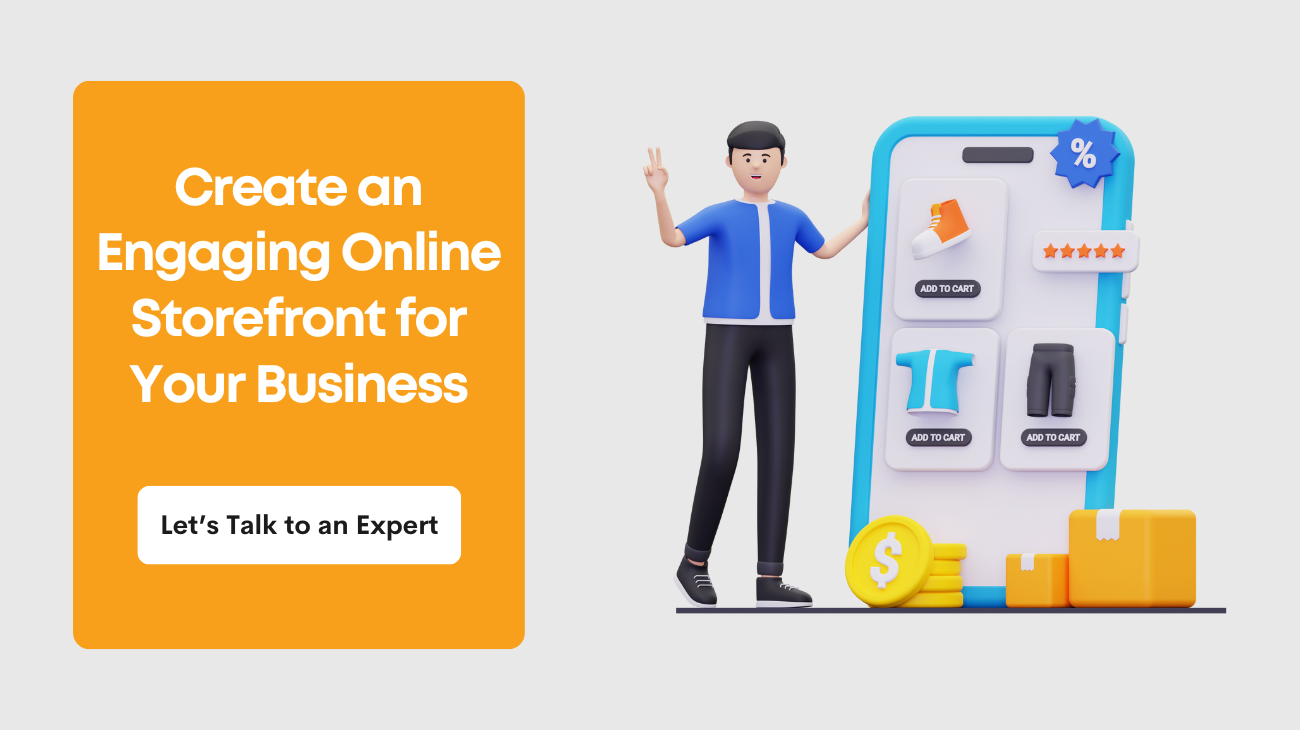Can you afford missing out on potential sales due to the limitations of your brick-and-mortar store? According to statistics, the online retail market is growing rapidly and is expected to reach 22% of global retail sales by the end of 2023. This highlights the importance of having a well-designed and functional e-commerce website to capture the attention of potential customers and maximize your sales.
But how can you develop a successful online store that stands out in the crowded digital market?
The solution lies in following a strategic e-commerce website development process that focuses on user experience, functionality, and optimization for search engines.
In this blog, we will guide you to create an effective e-commerce website that drives sales and boosts your business growth.
Secure Your Domain and Hosting
You should register your domain name as soon as you have decided on a business name and find an available URL. The ideal domain name you found might be taken during your e-commerce website’s design and development, so it is best to secure your domain name as soon as your business name is decided.
Establish Your Branding
Branding is major in establishing a deep connection between businesses and consumers. E-commerce website must have a memorable logo, color palette, and voice. These elements combine to create a user experience driven by the brand’s personality. A crucial aspect of branding is telling the story of the business and the people behind it. This helps humanize the brand and builds trust with customers.
Iconic brands such as Coca-Cola, Starbucks, and Apple have achieved this by having distinct visual identity, tone of voice, and personality. This emotional resonance is what creates brand loyalty among customers.
Read our recent blog for more awareness. Top 7 Roles of Branding in Business Marketing Success
Select Your e-commerce Platform
Various e-commerce platforms are available for running your online store, such as Magento, Shopify, or plugins like WooCommerce integrated with WordPress-based e-commerce websites. Each forum has its advantages and disadvantages, so it’s important to carefully consider your options before selecting the best fit for your e-commerce website.
Develop Your Content Strategy
When building an e-commerce website, it’s better to prioritize creating real content for more accurate representation of the end product early on in the process. Having a content strategy at the beginning of the development process is important. It involves determining what content is needed to communicate your brand’s story and showcase your products effectively. This may include content in the form of text, images, videos, and infographics.
Your content strategy will shape the funnel architecture of your website, and having understanding of your customers need, you can create a user-friendly and effective design.
Click here to learn more about Strong SEO Content Strategy: Pillar Pages and Topic Clusters
Ensure Website Security
Ensuring the security of your e-commerce website is paramount for the safety of your customers’ data and sensitive data about your products and and business. A security breach could lead to the loss of vital information or, even worse, the theft of your customers’ contact details, which could be misused for malicious purposes.
In addition to the risk of data loss, an unsecured website can severely damage your business reputation, not just on Google but across all search engines.
With the introduction of SSL certificates and HTTPS protocol, Google now flags websites without these components as unsafe, and users cannot visit these sites. This could result in lost potential orders, and your business may suffer the consequences of an expired certificate. So make sure you get an SSL certificate for your website and keep track of its validity.

Implement Website Search and Filtering
Even on non-commerce websites, visitors often use the search bar, therefore, it is crucial to provide advanced search functionality. For instance, you could offer visual search capabilities, allowing users to upload images of products they like and enabling your search engine to locate similar, if not identical, items.
Categories can be helpful for inspiring customers who need clarification on what they’re looking for, but in most cases, a simple search is sufficient and can help customers find what they need with just a few clicks.
Manage Registration and User Accounts
When creating e-commerce websites, registering an account can have benefits such as saving shopping history and delivery information. However, some users prefer a more streamlined process with a guest checkout or one-click buy feature. Given the numerous accounts people already have on the web, some customers may hesitate to register for another one to make a single purchase. In these cases, offering a guest checkout feature could help increase sales.
Other ways to promote your site are including your website address on order packaging or shipment confirmation emails. If you still want to collect customer data, you could offer alternative sign-in options such as social media logins or a simple form with basic contact information. With this information, you could auto-generate an account and email the customer’s login details.
Choose Coding Language or CMS
A content management system (CMS) simplifies storing, organizing, and managing all your website’s content, including text, images, and marketing materials. With a CMS, you can easily edit or add new information and ensure the changes are automatically updated on your website.
Using a CMS, you can select a pre-built solution such as PrestaShop, OpenCart, or Magento. These open-source solutions can be seamlessly integrated into your website’s code, providing a quick and efficient way to manage your content.
In addition, it’s essential to carefully consider your coding language selection when choosing a CMS. The most popular CMS options are built using languages such as PHP, Python, and Ruby, each with unique benefits and drawbacks. It’s important to assess the requirements of your website and select a CMS and coding language that best aligns with your needs.
Optimize for Mobile Devices and Responsiveness
It is estimated that by the year 2025, sales from mobile commerce will reach a total of $710 billion. Although consumers prefer purchasing through mobile apps, your e-commerce interface should still have a high conversion rate by providing a mobile-responsive design.
Walmart Canada, for instance, achieved a 20% increase in website conversions and a whopping 98% increase in mobile orders after launching a more responsive design. As the number of mobile users grows, investing in responsive design that includes adaptable typography and image sizes and mobile-specific features like hidden menus is critical. Optimizing the mobile site, including product descriptions, is essential to maximize conversions.

Website Design and Competitor Analysis
Creating a stunning e-commerce website doesn’t have to break the bank. With many free WordPress themes for e-commerce websites, businesses can build a high-quality online store without incurring high costs. From minimalist designs to feature-packed layouts, a free e-commerce theme suits every business need.
When designing an e-commerce website, it’s important to choose a color scheme that matches and complements the products being sold. For example, if your website sells game or fandom-related merchandise, the color scheme should include fonts and backgrounds that are relevant to the items available.
In the case of food-related e-commerce, a color range including green, yellow, and purple can be effective as these colors have been known to stimulate appetite. Additionally, it’s important to incorporate plenty of white space to ensure the site design and food items don’t clash.
It’s also essential to conduct a competitor analysis to determine what your competitors are doing and how you can differentiate your e-commerce website. Analyzing your competitors’ design, content, pricing, and promotions can help you identify areas of improvement for your own site. By understanding your competitors’ strengths and weaknesses, you can create a unique selling proposition and enhance your brand’s value proposition.
Related Revamp Your Dull Website Like A Pro With These 3 Simple Tools
Focus on UI/UX Design
Web users prefer simple and functional shopping carts. A simple shopping cart should involve minimal steps, but there are several ways to improve its functionality. One approach is to create three types of users: registered, unregistered, and guest. When a user clicks on the shopping cart, the first step should prompt them to either log in, register, or proceed as a guest. Upon registration or login, users should be automatically redirected to their full baskets to avoid discouragement from having to search for items again.
Alternatively, you can incorporate a one-step checkout process where all the steps are in a single dynamic window that updates when users input data. Another way to enhance the shopping cart’s functionality is by implementing cross-selling and upselling. This can be done by adding a section with products that may interest the user.
Determine Product Categories
Quality content is highly valued by users in e-commerce. Providing high-resolution images, video reviews, and comprehensive product details can significantly impact conversion rates. One downside of online shopping is that customers cannot physically examine or try on the product. Therefore, product descriptions are the only information available to make a purchasing decision. Including specific measurements for clothing, usage purposes for instruments, and energy consumption for appliances can all help convince customers to buy your product.
Capture Product Photos
While most people can take decent product photos with a basic setup, professional photography may be worth investing in for higher-quality images. Regardless of who takes the pictures, ensuring they are properly focused, white-balanced, and faithfully represent the product colors is important.
Additionally, having photo editing skills can further enhance the images and make them a better representation of your products. As online shopping doesn’t allow customers to interact physically with the products, it’s important to provide detailed product photos that capture all the important details. Multiple angles and closeups can convey more information and help customers better understand your products.

Craft Compelling Product Descriptions
Product descriptions are essential to an e-commerce website that helps customers make informed purchase decisions. They provide detailed information about a product’s features and benefits, guiding customers through deciding whether to add the item to their cart.
While it’s important to include specifications and features, a great product description goes beyond simply listing the details. It should connect with potential customers personally, using empathy to highlight the product’s benefits. For example, a product description for a tent could begin by emphasizing the customer’s need for a comfortable “home away from home.” The features section could mention key elements like “livable space,” “easy access,” and “headroom,” using language that resonates with anyone who has spent time camping.
Offer Product Options
When it comes to online shopping, customers want the ability to select the specific color, size, or other variants of the product they are interested in. Offering a selection option for these variants is essential for a positive customer experience as it lets them personalize their purchase and ensures they get what they want.
When developing your e-commerce website, make sure to include a clear and user-friendly selection process for these variants. This could be dropdown menus, color swatches, or other visual cues that allow customers to see and choose the options they want. It’s important to ensure that the selection process is easy to use and works seamlessly across all devices.
Add a Shopping Cart
The “Add to Cart” button is one of the most important elements of any e-commerce website. It serves as the gateway to the checkout process and is essential in converting visitors into paying customers. A clear and prominent “Add to Cart” button can make all the difference in driving sales and increasing revenue.
When designing your website, make sure that the “Add to Cart” button is easy to locate and visually stands out. Use concise language that clearly describes what the button does, such as “Add to Cart” or “Buy Now.” Consider using contrasting colors or other visual cues to make the switch more prominent on the page. Additionally, ensure that the button works seamlessly and quickly without any delays or glitches that could frustrate potential customers.
Accept Multiple Payment Methods
Offering multiple payment methods is pivotal for any e-commerce website. Customers want to pay for their purchases in a way that is both convenient and secure. By providing a range of payment options, you can attract more customers and increase sales.
When developing your website, ensure that the payment process is user-friendly and works seamlessly across all devices. Offer various payment options, such as credit cards, PayPal, Apple Pay, and others, of your target audience. Ensure that the payment process is secure, and that customers feel confident using it. Additionally, be transparent about any fees or charges associated with different payment methods so that customers know what to expect when they purchase.

Choose Shipping Software
Effective order fulfillment and shipping are critical for any business. Choosing the right shipping software can simplify the process, particularly when shipping large orders.
Shippo is a shipping software that seamlessly integrates with Webflow and offers many practical features, such as store integration, printing shipping and return labels, and tracking information for customers. It has an excellent reputation, with companies like Tuft & Needle, Etsy, and OfferUp using Shippo for their fulfillment platform. Shippo also provides offers multiple carrier options, including USPS, UPS, DHL Express, and FedEx, allowing businesses to select the best carrier for their needs.
Provide Customer Support
According to the payment methods report, millennials highly value personalization and appreciate individual recommendations from a support representative. While e-commerce businesses strive to provide this level of personalization, customer support is significant in resolving issues related to shipping, payment, returns, and more.
To ensure that customer support is easily accessible, it’s a good practice to have a dedicated contacts section on your website, with a clickable phone number or email displayed prominently at the top of each page. Additionally, mentioning your store’s physical address, phone number, main office, or warehouse on the website can significantly enhance credibility.
To cater to the younger population who prefer messaging over traditional phone calls, consider adding chat options like WhatsApp, Facebook Messenger, or other similar features. Incorporating these options can help engage customers and provide personalized support that meets their communication preferences.
Establish Your Return Policy
A clear and customer-friendly return policy is essential to any successful e-commerce website. Not only does it give your customers peace of mind and encourage them to make purchases, but it can also help protect your business from fraudulent activity and costly chargebacks.
When developing your e-commerce website, it’s important to consider the following factors when crafting your return policy:
- Return Timeframe: Determine when customers have to initiate a return or exchange after receiving their purchase. This timeframe can vary depending on the type of product being sold and your industry norms.
- Condition of Product: Clearly state the condition in which the product must be returned to be eligible for a refund or exchange. For example, if the item is damaged, missing parts, or has been used, it may not qualify for a return.
- Refund or Exchange: Decide whether you will offer a refund or exchange for returned items. It’s also important to outline any exceptions, such as final sale items, personalized items, or items purchased during a sale.
- Shipping and Handling: Determine who is responsible for the cost of shipping and handling returned items. Will the customer be responsible for these costs, or will your business cover them
- Returns Process: Clearly outline the process for initiating a return or exchange, including any required forms or documentation. Provide clear instructions for customers on how to package and ship their returns and how long the process will take.
- Communication: Provide clear and timely communication throughout the returns process to ensure customers are informed of their return or exchange status. This includes notifying customers when their recovery has been received when their refund or exchange has been processed, and any updates on their return status.
A well-crafted return policy can help build customer trust and ensure a positive experience when shopping on your e-commerce website. By considering the above factors, you can develop a policy that protects your customers and your business.
Prioritize Optimization
Nowadays, having a slow-loading website can have a detrimental effect on your business, and not just in terms of user experience. Google now flags websites with low loading speeds, and users may only bother visiting a website that takes less time to load.
Research from Think with Google shows that if a page takes up to five seconds to load, the likelihood of visitors bouncing increases by 90%. That’s why it’s essential to optimize your website and ensure it’s performing at its best.
SEO is critical in driving sales by improving your website’s ranking in search engines. This involves adding relevant keywords to your website’s content and meta information such as titles, descriptions, and alt tags for images. Many businesses overlook optimizing their visual content, as customers can find you through image searches.
Furthermore, involving an SEO specialist in the early stages of e-commerce website development is essential. The website should launch with all necessary meta tags. Still, an SEO specialist can also assist with organizing the page structure, creating a content strategy, building a mobile-friendly design, improving loading speed, and other critical aspects of website optimization.
Build Social Proof
Incorporating customer feedback is an effective way to enhance your site’s credibility. You can consider various ways to obtain and display customer feedback, such as incorporating written reviews or product unboxing videos. Another option is to allow customers to add their own video reviews and product images to the site.
Moreover, you can add a comment carousel to the main page, which displays links to products that have been reviewed. This feature can highlight customer feedback and further reinforce the authenticity and trustworthiness of your site.
Develop a Marketing Strategy
A well-crafted marketing strategy is essential for launching a successful e-commerce website, whether for an existing physical store or a new business venture. This strategy plays a critical role in shaping the website’s structure and determining the elements that contribute to its effectiveness.
Creating a marketing strategy early in the website development process allows you to identify the necessary features, such as social media sharing options or push notifications for desktop and mobile devices. It’s more efficient to incorporate these features during development rather than after launching the website.
Publish Supportive Articles
It’s important to have documentation related to the use of your website and the policies that govern it, such as FAQs, shipping information, return policy, cookie usage, and privacy information. These sections should be available on your e-commerce website from its launch.
Conclusion
Creating a well-designed e-commerce website is an effective way to begin selling products and services. Unlike e-commerce platforms such as marketplaces, online businesses can personalize their site’s features and designs to align with their brand image. The above list of e-commerce stores demonstrates a remarkable blend of creativity and usability.
E-commerce has presented new avenues for individuals to establish their online presence in the digital market. It takes a lot of work to develop a convenient, functional, high-performing online store that can attract customers, even with WordPress e-commerce websites and plugins or Shopify e-commerce website builder. With the projected estimation e-commerce will account for 95% of all transactions by 2040, ensuring your web store stands out from the rest is crucial. Creating a perfect web store can be overwhelming, from selecting the appropriate features and technology to designing and implementing them.
An e-commerce site is not just a place to sell products; it’s an opportunity for businesses to create an unforgettable brand experience that attracts new customers and turns them into loyal supporters. To achieve e-commerce success, selecting the right platform and implementing a marketing strategy that drives traffic and sales is necessary. With the right approach, your online store can become a powerful tool for growth and expansion.
At CyberX Studio, we customize the way cyberspace can elevate your business growth with the help of digital marketing services and skyrocket your revenues. We are the best digital marketing agency to strategize, develop, and execute robust and reliable web solutions and digital marketing systems for your business to succeed online.
FAQs
An e-commerce website is an online platform that allows businesses to sell their products and services online. These websites typically include features such as product pages, shopping carts, payment gateways, and order management systems.
With its vast array of integrations and customization options, WordPress is a powerful e-commerce platform. Whether you’re a small business or a large enterprise, the platform’s scalability and ease of use make it an attractive option. Plus, adding e-commerce features to your site is straightforward, with various themes and plugins available.
Create an e-commerce website using WordPress in the following nine steps:
- Find the ideal domain name for your website
- Register with a hosting provider to get your site online
- Install the WordPress content management system
- Set up and configure the WooCommerce plugin for e-commerce functionality
- Select a suitable theme to customize the look and feel of your site
- Add products to your online store
- Expand your site’s capabilities by installing additional plugins
- Craft persuasive content that drives conversions and sales
- Launch your site and make it visible to the public.
To create an e-commerce website with Shopify, you can follow these general steps:
- Sign up for a Shopify account and choose a pricing plan that suits your needs.
- Select a template or theme from the Shopify Theme Store, or design your own using the Shopify theme editor.
- Customize your piece by adding your logo, changing colors and fonts, and setting up navigation.
- Set up your products by creating pages and collections and adding product descriptions and images.
- Configure your payment options, including payment gateways, taxes, and shipping rates.
- Launch your website by publishing it and promoting it to potential customers.
The cost of a Shopify e-commerce website can vary depending on various factors such as the chosen plan, design, customization, integrations, and add-ons. Hiring a developer for customization and design can also range from a few hundred to several thousand dollars. The cost of additional apps and integrations can also add to the overall cost. Therefore, the total cost of a Shopify e-commerce website can range from a few hundred to several thousand dollars.
Businesses can optimize their e-commerce website for search engines by implementing on-page optimization techniques such as optimizing meta tags, including high-quality images and videos, using descriptive product descriptions, and implementing schema markup. They can also focus on building high-quality backlinks and creating a blog to drive traffic to their website.

Khadija Aamir
Web Developer
Meet Khadija Amir, a talented web developer with a passion for crafting exceptional online experiences. With a Bachelor’s degree in Computer Science and 1 year of professional experience, Khadija brings her expertise to the table with precision and dedication. Her passion shines through in every project she undertakes, as she strives to create seamless and engaging user experiences.



